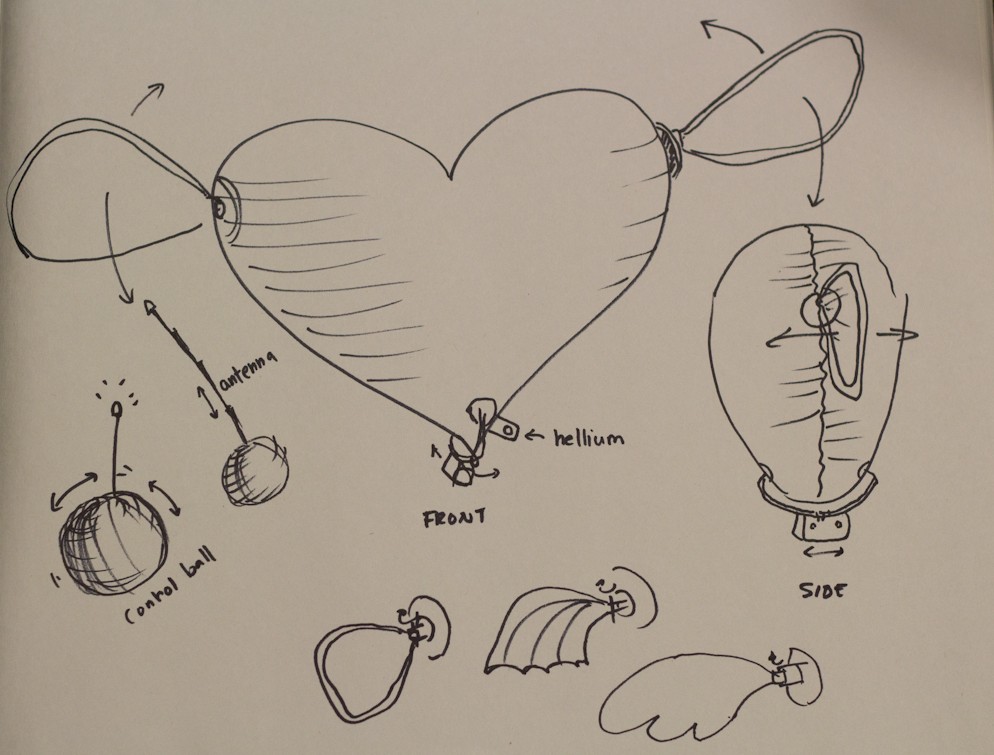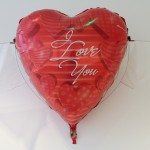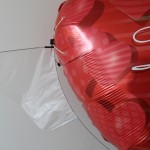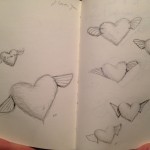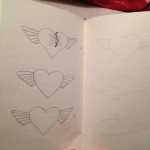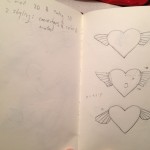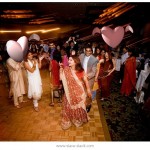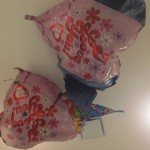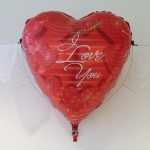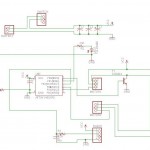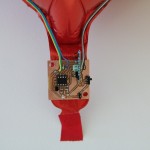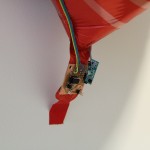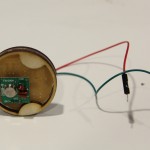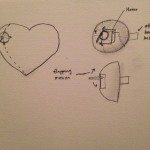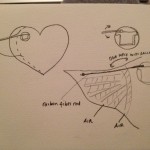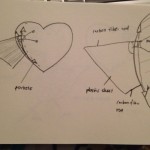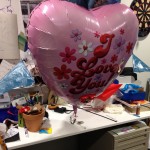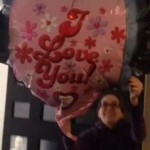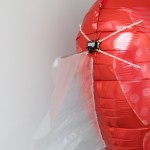The heart is a flying toy that is specially designed for wedding entertainment and decoration. It is a helium balloon in a lovable heart shape with mechanical wings. The heart is a lively toy. If you are not interacting with it, it will explore the space by itself and wiggle, asking for attention. Through a magical marble you can talk to the heart and ask it to fly.
Design and costumization:
The balloon is a heart shaped helium balloon that can be customized depending on the theme and style of the wedding decoration. The color of wing and balloon and the print on the balloon can be costumized. Since the wings are removable and easily attaced on the side of the balloon, even the shape of the balloon can be customizable.
In a series of design studies in Rhino and sketches I examined how the wing shape and size change the experience and what effect the arrangement of multiple balloons create. I made my design decisions with the goal to create a balloon that looks like a “normal” heart, a symbol of love, with some interesting accessories and clearly distinguish it from a heart-shaped creature. In addition I attempt to make the balloon appear harmless and welcoming, which is highly dependent on the proportion of the different parts and the arrangement of the balloons.
Electronics:
During the design process I experimented with different kinds of wireless communication. Infrared communication is a every cheap solution but requires line-of-sight. Therefore to ensure control from any direction the receiver can only be mounted at the bottom of the balloon. Another solution is RF communication. I tested a pair of cheap radio modules from a Chinese vendor. The quality of the receiver is very bad. I needed to optimized my RF-signal for the quality of the receiver and process the received data. In the next iteration of the hardware I am going to try a better RF-receiver chip.
Both transmitter and remote controller uses ATTINY 85 as its processor. I also considered using a modulator and demodulator instead of a micro-controller which would obsolete the programming step in the manufacturing process, but ATTINY was cheaper, more reliable and easier to purchase.
Electronics parts list:
- TG 11A and TG 11B radio pair
- ATTINY 85
- TLV2771
- piezo vibration sensor
- LEDs
- various resistors and capacitors
- zener diode
- switch EG1847-ND
- Lithium Ion Battery
- GWSPIC/STD/J Servo
Mechanics:
There are three major issues to be considered during the design process. Firstly, how to attach the wings to the balloon. Secondly how to attach the motor to the wings and the balloon. And lastly how to balance the balloon and make it light enough to fly. The sketches show the different designs that I implemented.
First design / second design / third design
For aesthetic reasons I changed the initial design many times and arrived at the design in the last picture. The connection between wing and balloon is clear, rigid and easily understood. They explain the idea that an subtle, strange, external attachment is put to the delicate surface of the heart. The clear connection point also indicate strength and stability. The wing is completely disconnected from the balloon and can be easily attached with one step. This means that the wing can be manufactured independently from the balloon.
Mechanical parts list:
- thin plastic sheet or Mylar sheet
- carbon fiber rods
- laser cut hooks
- laser cut motor housing
- robber band
- double sided tape and glue
Manufacturing:
Assume production size of 20 pieces.
PCB: the electronics are right now at a debug state. For the manufacturing process the size of the PCB can be reduced to half of the size at the moment, which means 1 – 2 dollar per piece.
Electronics parts:
- 10$ replace TG 11A and TG 11B radio pair with
- 1$ ATTINY 85
- 0.83$ TLV2771
- 2$ piezo vibration sensor (need to replace that)
- 1$ LEDs
- 1$ various resistors and capacitors
- 0.02$ zener diode
- 0.84$ switch EG1847-ND
- 2$ replace Lithium Ion Battery with coin cell batteries
- 12$ GWSPIC/STD/J Servo
- 2$ PCB
= 32.69$
Mechanical parts:
- 0.02$ thin plastic sheet or Mylar sheet
- 4$ carbon fiber rods
- 0.2$ laser cut hooks
- 0.2$ laser cut motor housing
- 0.2$ robber band
- 0.5$ double sided tape and glue
= 5.12$
Balloon:
= 2$
Total:
= 41.81$
Assembly:
The PCB will be pre-assembled. There are less than 10 components on each PCB and can therefore be assembled in reasonable short time. The tool I need for this assembly step is a soldering station. The wing need to be pre-assembled as well. For each wing there are 8 pieces that need to be glued, which make about 16 steps every balloon in total. The gluing process need hand labour and is therefor more expensive. Approximately 10 hooks need to be made for each balloon. These are probably available on the market. The tool I need for this step is a laser cutter with about one hour machine time. After the delivery, the user need to execute the final assembly step, which is to glue the hooks to the balloon and put the wings onto the balloon. These steps are easy and done withing 10 minutes.
Total 30 hours (three days for one person).
Packaging and shipping:
The product fits into an big envelope. the wings define the size of the packaging. A 80 cm X 50 cm flat cardboard envolope could be used for shipping. The packaging and shipping in total will be about 12$ – 15$.
Total shipping cost 15$.
